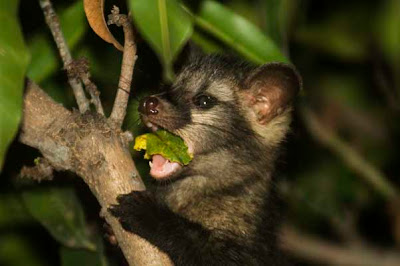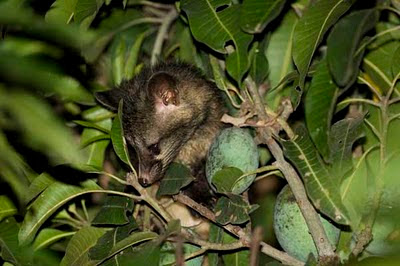I should have been in Bhopal on 14th but couldn't go there due to staff. Computer repair and plants were the two major jobs of this visit. Hariom dropped me at Umaria station to board the Ambikapur Jabalpur train. Very Good train for Jabalpur, hardly takes three and half hours to complete the journey. Kishan Pillai runs a Taxi now so I used his Taxi to go to SFRI and Other places.
Aristolochia was on top of my prioriy list. I found seven plants of it so I bought them all. Another plant was Stevia. I love it. Question is How long I will be able to save it from leaf tasters. It is sweet, bloody sweet.
Bhopal was wet, moving on scooter was difficult. Ajeet dropped me at the station. I was amazed that they allow him to drive car in night. Train journey was good, I slept all the way through uptill Madan Mahal.
Best thing I saw was Baya nesting in a well. Hardly 15 feet from the ground one can see about 12 nests in process of completition. Male trying to attract female through the display on their cup shaped nest. I didn't took my camera with me so cant show any photos but soon I will try to get it done.
Pyari is back in Chakradhara with her cubs after spending more than five months in Dobha forest.
Saturday, July 24, 2010
Sunday, July 18, 2010
Animal and Insect life in our Garden



Few days of rain and few open sunny days put the dead garden back in to life once again. This year summer was hard on plants. We decided to water only trees or those plants that can tolerate the heat and survive so many of our flower plants and food plants for butterflies died this summer but monsoon brought them back.
In the morning small Gulmohar, Yellow Elder and Zinia attracts Lime and Common Crow Butteflies. Few days back there were lots of Common Rose and Crimson Rose in the garden but none since last three days. Tridax attracts all the small size butterflies but surprisingly no grass yellows seen so far. All three kind of Parakeet visits the garden but different times. Plum Headed and Alexandrine come for Guava's in winter, than only Plum Headed comes for Mangoes when unripe and hard and once they are ripen than Rose Ringed Parakeet comes to finish them.
We have Dussehari (10 trees), Chaunsa (9 trees) & three trees of desi mangoes. Other animal that we have as a resident / visitor to the garden is a family of Indian Palm Civet. Now they are all adult in size and devouring the Mango, Guava, Papaya and Cheeku in the night. We see their poo every where in the morning. They comes to our Veranda. Here they poo every where may be because of cats. They just wants to to leave their scent mark on top of theirs.
It was great fun photographing them. Few years back I photographed them eating Mango and Guava. Our nieces Munmun and Mahi love watching them in the night. Sometimes these Civets ignore them completely. Once a female brought a big mango and started eating it about a feet away from Munmun's feet.
Crows are the other birds who always knows before us that which mango is ripened. They bring it down on ground then beetles and butterflies start enjoying it. After few showers of rain Mango's start getting bugs inside. This is because a moth lays its eggs in them.
This morning Common Crow, Great Eggfly and Lemon Pansy are seen feeding on ripen mango on ground.
Wednesday, July 14, 2010
Red headed vulture killing White-backed Vulture in Bandhavgarh

 Bandhavgarh national Park is situated in Umaria distt of Madhya Pradesh India. Four species of Vultures Long-Billed Gyps indicus, Red-Headed Aegypius calvus,Egyptian Neophron percnopterus and Whit-rumped Gyps bengalensis -are resident here. On May 28, 2008 at 0701 am we spotted a White -rumped Vulture near a stream in the Dadra meadow. It appeared sickly in a sitting posture with head bowed. Nearby a couple of Red-headed Vultures were feeding on a carcass of what appeared to be another dead vulture. At 0705 am while we still watched the sickly bird walk further away, a Red-headed Vulture flew from a nearby tree and landed on the unaware bird, followed by another within seconds.
Bandhavgarh national Park is situated in Umaria distt of Madhya Pradesh India. Four species of Vultures Long-Billed Gyps indicus, Red-Headed Aegypius calvus,Egyptian Neophron percnopterus and Whit-rumped Gyps bengalensis -are resident here. On May 28, 2008 at 0701 am we spotted a White -rumped Vulture near a stream in the Dadra meadow. It appeared sickly in a sitting posture with head bowed. Nearby a couple of Red-headed Vultures were feeding on a carcass of what appeared to be another dead vulture. At 0705 am while we still watched the sickly bird walk further away, a Red-headed Vulture flew from a nearby tree and landed on the unaware bird, followed by another within seconds.By now the first vulture was pecking at the white rumped as it sat on its back. The White-rumped Vulture tried to defend itself by counter attacking with its beak, but it seemed unable to escape the grips of the heavier and healthier bird anchored on its back. The second Red-headed Vulture appeared unwilling to join the attack, possibly due to hierarchy, and simply stood watching.
After ten minutes of suffering,the White-rumped Vulture manage to escape and hop off to safety after the Red-headed Vulture became distracted by more arrivals.There were no further attacks on the bird for the following fifteen minutes.
The following morning at the same spot there was a gathering of 8 or 9 Red-headed Vultures. They were feeding on the carcass of a recently dead White-rumped Vulture. One bird appeared dominant and as it fed the others stood around watching. It is probable that this was the carcass of sick looking White-rumped Vulture we have observed the previous day.
Vultures feeding on dead Vultures may not be uncommon in Bandhavgarh, however, it is the first time that Vultures appearing to attack sick looking Vultures for food has been documented.
Surely this does not mean that these vultures in Bandhavgarh are facing any kind of starvation. This could be a case of opportunist behaviour for getting easy convenient.
Expert Comments: The Vulture sitting on the back of the White-rumped Vulture is a regular posture of an attacking Vulture. Vultures do this for driving other Vultures from food or a perch. It is unlikely that a Red-headed Vulture was attempting to kill White-rumped Vulture. Vultures do sometime takes live prey, but only small ones like Turtles,Rats or Lizards. Vultures do sometime feed on other dead Vultures.
This was published in Bombay Natural History Society journal, Hornbill, Jan-March, 2009.
We thought and our thought were confirmed by Mr Patric Benson and Mr Munir that this bird was a juvenile Long-billed Vulture but BNHS people thought it otherwise hence it published as White-backed Vulture.
Subscribe to:
Posts (Atom)